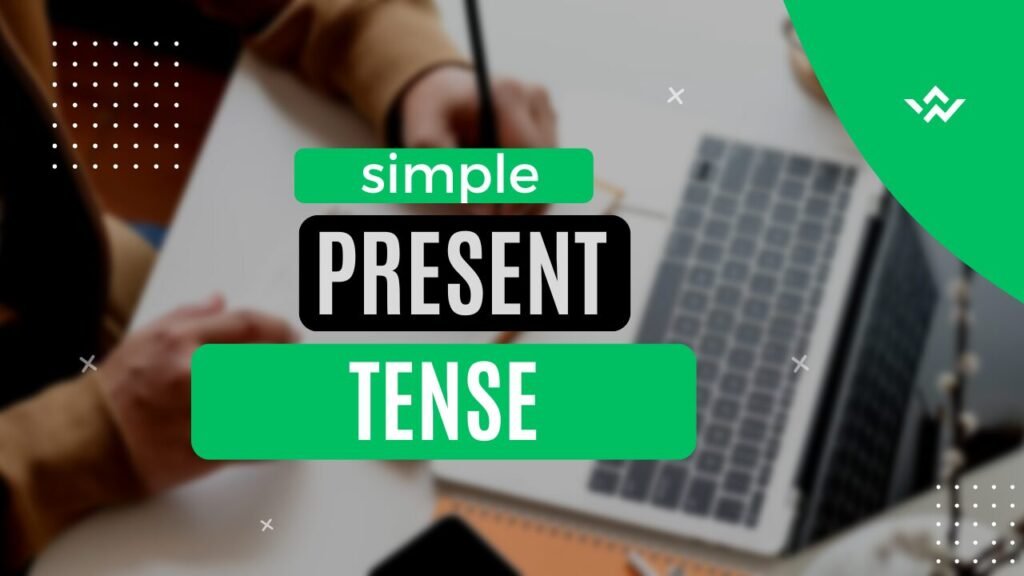Definition:- simpe present tense is used for an action happens every regularly.
Example:- I speak English every day.
The present simple tense is one of the most essential tenses in English. It’s used to talk about things we do regularly, general truths, facts, and habits.
All you have to learn is the rules for building positive, negative, and question sentences, and practice not making typical mistakes,
and you’ll find it easy to use! And there’s even an exercise with answers at the end where you can practice your skills.
Table of Contents
When Do We Use the Simple Present Tense?
How to Use the Simple Present Tense: Rules and Examples
How to Form the Simple Present Tense
How to Make the Simple Present Negative
How to Ask a Question in the Simple Present
Simple Present Tense Exercise with Answers
Conclusion
When Do We Use the Simple Present Tense?
1. Describing Habits and Routines
This tense is great for describing what we always do, like daily habits:
I wake up at 6 a.m. every day.
She goes to the mosque every Friday.
We eat lunch at noon.
2. Describing Facts and Universal Truths
We also use this important tense to describe things that are always true or universal facts:
The sun rises in the east.
Birds migrate south for winter.
Water boils at 100°C.
3. Describing Schedules
Use the this tense for activities that take place according to a set schedule or timetable:
The train departs at 1:00 a.m.
The store opens at 7 a.m. each day.
Our flight lands at 6 p.m.
4. Using Stative Verbs
Stative verbs describe states or conditions rather than actions. These verbs are generally employed in the this tense:
I know the solution.
She loves pizza.
This car belongs to my father.
How to Use the Simple Present Tense: Rules and Examples
This essential is one of the most basic verb tenses in English. It is used to talk about routine activities, general facts, and habitual actions, or actions that take place in the present time. Knowing how to use the Present simple tense will allow you to communicate clearly in many circumstances.
In this article, we will describe the basics on how to form the present simple tense, the rules, provide examples and show how to make negative sentences and questions.
How to Form the Simple Present Tense
It is quite simple to create the this tense once you find the structure.
1. For most verbs (I, you, we, they): Just use the base form of the verb.
- They work from 9 a.m. to 5 p.m.2.
- I play tennis every Sunday.
For the third-person singular (he, she, it): You will need to add -s or -es to the base form of the verb.
- He plays basketball on weekends.
- She watches movies in the evening.
Note: If the verb ends in -o, -ch, -sh, -x, or -z, add -es.
Go → Goes
Catch → Catches
wash → washes
Simple Present Tense Examples
Below are illustrations of the this tense:
• I learn English every day.
• She speaks French with ease.
• They go to school at 7 p.m.
• He works at a bank.
• We enjoy reading books during our leisure time.
• The earth revolves around the sun.
• It rains a lot during April.
Simple Present Tense Rules
This tense adheres to some basic rules for usage. Here are the main rules to remember:
1. Use the base form of the verb for I, you, we, and they:
I enjoy reading books.
We visit our grandparents every weekend.
2. Add an -s or -es for 3rd person singular (he, she, it)
He runs every morning.
She likes to cook.
3. For verbs ending in -y (preceded by a consonant), change -y to – ies:
Carry → Carries
Study → Studies
4. For verbs in -o, -ch, -sh, -x, and -z, add -es:
Go → Goes
Fix → Fixes
This image will briefly explain the 5 rules of simple present tense

many of us make mistakes When we are using simple present tense so avoid these mistakes in the following image.

How to Make the Simple Present Negative
Read also: present continuous tense, present perfect tense and present perfect continuous tense
In the this crucial tense, to make a sentence negative, we use do not (don’t) or does not (doesn’t) and the base form of the verb.
1. For I, you, we, and they, use do not (don’t).
• I don’t like coffee.
• They don’t speak Spanish.
2. For he, she, and it, use does not (doesn’t).
• He doesn’t eat meat.
• She doesn’t go to school on weekends.
How to Ask a Question in the Simple Present
To ask a question in the this tense , use do or does at the beginning of the sentence, then the subject, then the base form of the verb.
1. For I, you, we, and they: Use do.
Do you like pizza?
Do they play soccer every day?
2. For he, she, and it: Use does.
Does she work from home?
Does he watch TV every night?
Simple Present Tense Formula
To summarize, here’s the formula for forming sentences in the in this tense:
- Affirmative sentences:
- Subject + base verb (for I, you, we, they)
- Subject + base verb + -s/es (for he, she, it)
- Negative sentences:
- Subject + do/does + not + base verb
- Questions:
- Do/does + subject + base verb?
Simple Present Tense Exercise with Answers
Here are a few exercises to help you practice the Simple Present tense. Try filling in the blanks with the correct form of the verb.
Exercise 1: Complete the sentences with the correct form of the verb in the Simple Present tense.
- She ________ (play) the piano every day.
- We ________ (go) to the movies on Fridays.
- They ________ (work) in an office.
- He ________ (not like) coffee.
- I ________ (study) English at school.
- It ________ (rain) a lot in spring.
Answers:
- plays
- go
- work
- doesn’t like
- study
- rains
Exercise 2: Write questions in the Simple Present tense.
- You / like / ice cream
- They / play / basketball
- She / go / to the gym
- He / have / a dog
- We / watch / movies
Answers:
- Do you like ice cream?
- Do they play basketball?
- Does she go to the gym?
- Does he have a dog?
- Do we watch movies?
Simple present tense quiz: Choose the Correct answer
Simple present tense FAQs
Here are six of the most frequently asked questions on Google related to the Simple Present tense:
What is the Simple Present tense used for?
The Present simple verb form is typically employed to discuss habitual actions (including routines), generic facts, and general truths. This verb form can also be used to describe scheduled events and permanent situations.
How do you form the third-person singular in the Simple Present tense?
For third-person singular (he, she, it), one adds -s or -es to the base form of the verb (for example, “He works,” “She goes”). If the verb ends with certain letters like -o, -ch, -sh, -x or -z, –es is the spelling used.
When do you use ‘do’ and ‘does’ in the Simple Present tense?
Use do with I, you, we, and they (for example, “I do not like,” “We do our homework”). Use does with he, she, and it (for example, “She does not like,” “He does his homework).
Can the Simple Present tense be used for future actions?
Yes, this tense can refer to future actions if the future actions are scheduled or timetabled, for example, “The train departs at 5 p.m.,” or “The meeting starts at 10 a.m.”
What is the difference between the Simple Present and present continuous?
Simple Present is used to indicate habitual actions, facts, or general truths (e.g., I eat breakfast every day) and Present Continuous refers to:
(1) actions that are occurring at this moment, or (2) and for actions that are temporary (e.g., I am eating breakfast right now)
How do you ask questions in the Simple Present tense?
To make questions in the this tense use do or does to begin the sentence, then a subject and base verb (e.g., Do you work today? or Does she play tennis?).
Conclusion
This tense is an important tense in English and can be used to express habitual actions, routines, and general truths and facts. If you apply the rules of verb tense conjugation and understand when to use it, you will be able to write and speak in this crucial tense correctly. Whether you are making affirmative statements, negating sentences, or forming questions, understanding and using the simple present will enhance your ability to communicate in English.
Continue to practice with exercises and authentic examples, to support your comprehension.
read also
also watch this
Simple present quiz
If you understood the lesson well, try this quiz



Pingback: Simple future tense- definition and examples - Dirir Academy
Pingback: Simple past tense: definition, rules, and examples - Dirir Academy
Pingback: How to Use the Present Perfect Tense in English? - Dirir Academy
Pingback: The difference present Perfect and Past Simple - Dirir Academy
Pingback: Past Continuous Tense - Example - Dirir Academy
Pingback: Past Perfect Tense Explained: Structure, Examples, and Usage - Dirir Academy
Pingback: Present Perfect Continuous Tense: Rules & Examples - Dirir Academy